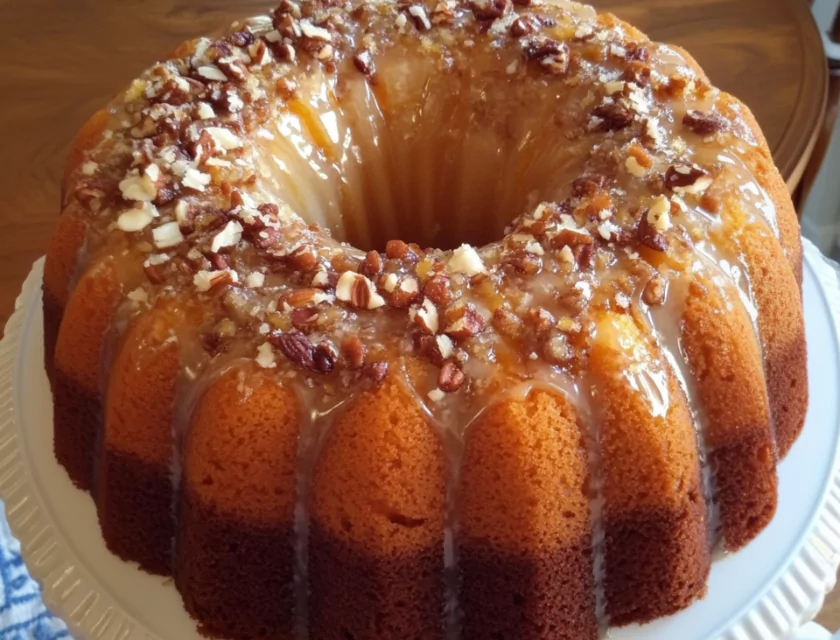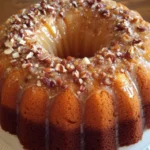Orange Juice Cake is a soft, citrus-infused dessert that brings out the zesty freshness of oranges in every bite. This cake is incredibly moist, flavorful, and easy to prepare, making it perfect for family gatherings, holidays, or casual indulgence. The secret lies in using fresh orange juice and a buttery glaze that soaks into the cake, creating a melt-in-your-mouth experience.

This cake has a Southern baking influence, where citrus flavors are often used to enhance traditional baked goods. Its simple ingredients and effortless preparation make it an excellent choice for both beginner and experienced bakers.
Brief History & Cultural Significance
Orange-based cakes have been around for centuries, but the modern Orange Juice Cake gained popularity in the mid-20th century, thanks to the availability of cake mixes and instant pudding. The use of bundt pans became widespread in the 1950s, making it easier to create beautifully shaped cakes with even baking.
Oranges have long been associated with prosperity, health, and good fortune, particularly in Mediterranean and Southern U.S. culinary traditions. The combination of citrus and butter creates a refreshing yet rich cake that has remained a household favorite for generations.
Preparation Phase & Essential Tools
- Prep Time: 10 minutes
- Cook Time: 35-40 minutes
- Cooling Time: 20 minutes
- Total Time: ~75 minutes
- Servings: 12 slices
Essential Tools & Equipment
To achieve the perfect texture and flavor, it’s crucial to use the right tools:
- Bundt Pan (10-12 cup capacity) – Ensures even baking and a beautiful cake shape.
- Electric Mixer – Helps incorporate air for a light, fluffy texture.
- Saucepan – Used for preparing the buttery orange glaze.
- Toothpick or Skewer – Allows the glaze to penetrate the cake for extra moisture.
Importance of Each Tool
- A non-stick bundt pan prevents sticking and allows for easy cake removal.
- An electric mixer ensures the batter is well-blended but not overmixed.
- The skewer technique ensures every bite of cake is infused with orange flavor.
Preparation Tips
- Use room temperature ingredients – This ensures even mixing and a smoother batter.
- Grease and flour the bundt pan thoroughly to prevent sticking.
- Sift the dry ingredients to avoid lumps and ensure a uniform batter.
- Use fresh orange juice rather than bottled for a more vibrant flavor.
Ingredients List
For the Cake:
- 1 (15.25-ounce) box yellow cake mix (Betty Crocker or Pillsbury recommended)
- 1 (3.4-ounce) box instant lemon pudding mix (adds moisture and enhances citrus flavor)
- ¾ cup vegetable oil (can be substituted with melted butter for a richer taste)
- ¾ cup orange juice (freshly squeezed is best, but store-bought works too)
- 4 large eggs (adds structure and richness)
For the Glaze:
- 2 cups powdered sugar (creates a smooth, sweet glaze)
- ¾ cup orange juice (infuses citrus flavor into the cake)
- 4 tablespoons unsalted butter (adds richness and shine to the glaze)
Optional Additions:
- 1 teaspoon orange zest (for an extra citrus kick)
- 1 teaspoon vanilla extract (enhances overall flavor)
- 1 tablespoon Grand Marnier or orange liqueur (adds depth to the glaze)
Step-by-Step Instructions
Preparing the Cake Batter
- Preheat the oven to 350°F (175°C).
- Grease and flour a 10-12 cup bundt pan to prevent sticking.
- In a large mixing bowl, combine the cake mix, pudding mix, vegetable oil, orange juice, and eggs.
- Use an electric mixer on medium speed for about 2 minutes until smooth.
- Pour the batter into the prepared bundt pan, smoothing the top with a spatula.
Baking the Cake
- Place the bundt pan in the center of the oven and bake for 35-40 minutes.
- The cake is done when a toothpick inserted into the center comes out clean and the cake starts to pull away from the edges of the pan.
- Allow the cake to cool in the pan for 10-15 minutes before preparing the glaze.
Preparing the Orange Glaze
- In a small saucepan, combine powdered sugar, orange juice, and butter.
- Heat over medium-low, stirring constantly until the butter has melted and the glaze is smooth.
- Remove from heat and let the glaze cool slightly.
Glazing the Cake
- Use a toothpick or skewer to poke holes all over the cake while it’s still in the pan.
- Slowly pour the warm glaze over the cake, letting it seep into the holes.
- Let the cake sit for 15-20 minutes, allowing the glaze to absorb fully.
Unmolding & Cooling the Cake
- Place a serving plate over the bundt pan and gently flip it over to release the cake.
- Let the cake cool completely before slicing.
- For the best flavor, let the cake rest for at least 8 hours before serving.
Serving Suggestions
- Dust with powdered sugar for an elegant finish.
- Top with fresh orange slices or zest for added decoration.
- Pair with a cup of coffee or tea for a delightful treat.
Storing & Freezing Tips
- Room Temperature: Store in an airtight container for up to 3 days.
- Refrigerator: Keeps fresh for 5 days in an airtight container.
- Freezing:
- Wrap slices in plastic wrap and aluminum foil.
- Freeze for up to 3 months.
- Thaw at room temperature before serving.
Perfect Pairings: What to Serve with Orange Juice Cake
Orange Juice Cake is delightfully moist and citrusy, making it a versatile dessert that pairs well with various sides and beverages. Whether you’re serving it for breakfast, brunch, or dessert, these pairings will enhance the overall experience.
1. Fresh Fruit Salad
A mix of strawberries, blueberries, kiwis, and oranges complements the cake’s citrus notes. The natural sweetness and acidity of fresh fruit provide a refreshing contrast to the rich, buttery cake.
2. Whipped Cream & Berries
Light and airy whipped cream adds a creamy texture without overpowering the cake. Topping the cake with raspberries, blackberries, or pomegranate seeds enhances its visual appeal and introduces a slight tartness.
3. Vanilla Ice Cream
A scoop of classic vanilla ice cream pairs perfectly with the warm, citrus-infused flavors of the cake. The cold ice cream melts slightly over the cake, creating a heavenly contrast of textures.
4. Hot Coffee or Espresso
The slight bitterness of coffee balances the cake’s sweetness, making it a perfect pairing for a relaxed afternoon treat or a brunch dessert. A dark roast espresso enhances the citrus notes even further.
5. Iced Tea or Lemonade
For a refreshing, summery pairing, serve the cake with iced tea (sweet or unsweetened) or a tall glass of homemade lemonade. Both drinks complement the cake’s citrus profile.
6. Cream Cheese Frosting (Optional Topping)
For an indulgent twist, top the cake with a light cream cheese glaze. The tanginess of the cream cheese balances the cake’s sweetness and adds a rich, velvety texture.
7. Roasted Nuts & Honey Drizzle
Chopped toasted almonds, pecans, or walnuts add crunch, while a light drizzle of honey enhances the citrus notes and provides additional depth of flavor.
8. Citrus Cocktails (Mimosas, Orange Sangria, or Bellinis)
For a brunch or celebration, pair the cake with a mimosa (orange juice & champagne), a citrusy sangria, or a peach bellini. These cocktails mirror the cake’s vibrant citrus profile.
Nutritional Information & Health Benefits
Orange Juice Cake is a rich and indulgent dessert, but understanding its nutritional value can help you make mindful choices.
Calories & Macros Per Serving (Approximate Values)
- Calories: ~320
- Carbohydrates: 45g
- Sugar: 30g
- Fat: 14g
- Saturated Fat: 3g
- Protein: 4g
- Cholesterol: 50mg
- Sodium: 280mg
Key Nutrients from Orange Juice
- Vitamin C: Supports immune function and skin health.
- Antioxidants: Help reduce inflammation and oxidative stress.
- Potassium: Supports heart and muscle function.
Healthier Ingredient Substitutions
- Use fresh orange juice instead of store-bought juice with added sugars.
- Replace vegetable oil with unsweetened applesauce for a lower-fat alternative.
- Swap some of the powdered sugar in the glaze with honey or maple syrup for a natural sweetener.
Common Mistakes & How to Avoid Them
Even the simplest recipes can go wrong if a few key steps aren’t followed. Avoid these common mistakes to ensure your Orange Juice Cake comes out perfectly every time.
1. Using the Wrong Cake Mix
Not all cake mixes are created equal. Stick with a moist yellow cake mix, as it has the best structure and flavor for this recipe. Avoid cake mixes labeled as “light” or “angel food”, as they can make the cake too airy.
2. Overmixing the Batter
Overmixing can cause the cake to be dense and tough. Once the ingredients are combined, mix for only 2 minutes on medium speed until just incorporated. A few lumps are fine—overworking the batter leads to gluten development, which affects texture.
3. Not Greasing the Bundt Pan Properly
Bundt cakes can easily stick to the pan, ruining the beautiful shape. To prevent this:
- Use butter or non-stick baking spray, making sure to coat all crevices.
- Lightly dust the pan with flour after greasing for extra security.
- If using a non-stick pan, check for scratches or worn coating, as an old pan may cause sticking.
4. Overbaking the Cake
Orange Juice Cake should be moist and tender. Overbaking will make it dry.
- Check the cake at 35 minutes by inserting a toothpick.
- If the toothpick comes out clean with a few crumbs, the cake is ready.
- If it’s completely dry, it may be slightly overbaked.
5. Skipping the Skewer Holes for the Glaze
One of the biggest mistakes is not allowing the glaze to fully penetrate the cake.
- Poke deep holes using a skewer or toothpick before pouring the glaze.
- Pour the glaze slowly and evenly, allowing it to soak into every part of the cake.
6. Pouring the Glaze Too Late
For the glaze to infuse into the cake, pour it while the cake is still warm.
- If the cake cools completely, the glaze will sit on top instead of soaking in.
- Let the cake absorb the glaze for at least 15-20 minutes before inverting it onto a plate.
7. Not Letting the Cake Rest
Many people cut into the cake too soon, but letting it rest for at least 8 hours enhances the flavor. The citrus and buttery notes intensify over time, resulting in a more flavorful and tender cake.
8. Using Bottled Orange Juice Instead of Fresh
While bottled juice can work, it lacks the natural freshness and acidity that freshly squeezed orange juice provides. Fresh juice enhances both the cake and the glaze’s citrusy brightness.
9. Storing the Cake Incorrectly
- Never store the cake uncovered—it will dry out.
- Use an airtight container to keep the cake moist for up to 3 days at room temperature.
- For longer storage, refrigerate for up to 5 days or freeze individual slices for easy defrosting.
10. Cutting the Cake Too Soon
Letting the cake cool completely before slicing is crucial. Cutting it while warm can cause crumbly, uneven slices and loss of moisture.



Leave a Comment